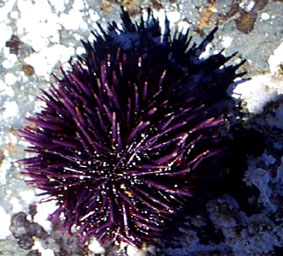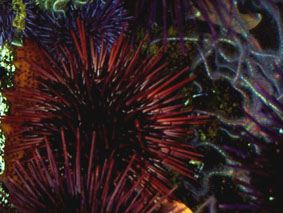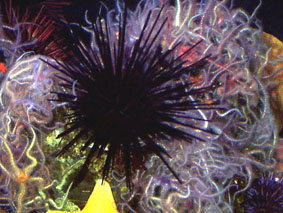
Phylum to Order
Phylum - Echinodermata
Although past their zenith following their post-Paleozoic adaptive radiation - echinoids are still highly successful, diverse and conspicuous marine animals. The calcification of echinoid endoskeleton evolved during the Mesozoic era and has contributed to the extensive preservation of their fossil records. Echinoids occur in marine environments ranging from the intertidal zone to depths greater than 7,000m. Regular echinoids are so flexible in their diet that they are rarely restricted by food availability. However, they are limited in their distribution due to geographical barriers (i.e. land basins) and oceanic currents.
Echinoderms are enterocoelous coelomates with a pentaradiate form and no definite head or brain. Echinoderms can be readily differentiated from other groups of organisms through unique physical and morphological attributes that include:
1) possession of a calcified spiny endoskeleton - made of five tight fitting plates 2) a water vascular system for nutrient uptake, gas exchange and movement 3) dermal brachiae and 4) a rigid spine or pedicellariae bearing plate.
Organisms in this class have 5 pairs of ambulacral rows that are homologous to the 5 arms of a sea star.
They are bilateral in symmetry as larvae and subsequently metamorphosize into radiality or biradiality. Because of this, many biologists believe that sea urchins were once ancestors to sessile organisms and thus, developed radial symmetry as an evolutionary adaptation to increase nutrient and gas exchange.
Class - Echinoidea
There are ten classes in this phylum. Sea urchins are grouped as Echinoidea. Until recently, there was a clear-cut distinction between Echinoidea and other classes because they possess what was believed to be a unique lantern for mastication. However, the echinoid type lantern has been found in Ophiocistioidea and Ordovician echinoids - making them not as distinct as once believed.
Subclass - Regularia or Endocyclica
Sea urchins are assigned to the subclass Regularia or Endocyclica. They are distinguishable from the only other extant subclass Irregularia because of their well-developed lantern, center placement of periostome and perioproct and two to five gonads that are sometimes fused.
Order - Camarodonta
Camarodonta (to which sea urchins belong) along with Aulondonta and Stirodonta were raised to the rank of Order following Mortensen. But many biologists believe that of the six total orders, these three should be reduced to Suborders under the order Centrechinoida because they differ only in the details of their lantern. The order Centrechinoida is characterized as having a regular test, off-centered periproct opposite its mouth and two columns of plates in each ambulacrum.
Family to Genus
Family - Echinidae
Sea urchins are classified into six families based on the sculpturing and details of their test, and the details of their pedicellariae. In Echinidae, each valve of the pedicellariae has a poison sac and several teeth lining its periphery with a single, large, pointed tooth in the center. There are seven genera of Echinidae. Two are common in the moderate depths off the Southern California coast, they are the Strongylocentrotus and Lytechinus.
Genus - Strongylocentrotus and Lytechinus
Aside from color and characteristics of their spines, the two genera are not much different from each other. On the whole the number of coronal plates and tubercles are greater in Lytechinus than Stronglyocentrotus.
Family to Genus
Family - Centrechinidae
The order Centrechinoida has only one family, Centrechinidae. They are classified as having compound ambulacral plates, an unplated peristome and the base of their corona is resorbed.
Genus - Centrostephanus
There are seven genera in the Centrechinidae family. Of these, only Centrechinus and Centrostephanus are found in Southern California. Members of the genus Centrostephanus exhibit longer, more slender, imbricate spines which are molted with purple color.
Species
Strongylocentrotus purpuratus (Stimpson , 1857). The common name for this specie is Purple Sea Urchin. The diameter of their test is about 85mm and it is almost completely covered by spines. These spines are about 10mm long, acute and stout. They also have a double series of primary spines in each ambulacral and interambulacral plate. The distribution of S. purpuratus is from Lower California (southern limit at Baja California, Mexico) to Vancouver Island.

Strongylocentrotus franciscanus (Agassiz, 1863) - the Red Sea Urchin occupies the same habitat as S. purpuratus and hence, cross-fertilization is common. Color is probably the most useful factor for distinguishing between the two species. In S. purpuratus the juvenile is green but turns purple to deep maroon with time. S. franciscanus turns almost black from a fawn-brown color as juvenile. They are relatively large, measuring to about 175 mm in test size, with only about 1/3 of it being covered by spines. In a solution of 4% Formalin and some corrosive sublimate S. franciscanus will turn bright green and then return to its red-brown color upon drying. They are abundant in the areas off of the southern California coast.

Lytechinus anamesus (Clark, 1912) - the White Sea Urchin is the most common sea urchin in moderate depths off the southern California coast. They are generally small; the largest is only about 37mm in size. When young, these urchins are very light colored, usually cream or white. However, by the time they reach 8mm - 10mm they begin showing blotches of gray or dull green across their cream colored test surface. The spines of L. anamesus are acircular and unicolor (cream or white). Their primary spines are yellowish-brown to a rusty, dull gray. Lytechinus anamesus is distributed in Lower California and adjoining islands, particularly, near Catalina Island.
Centrostephanus coronatus (Verrill, 1867), commonly known as the Crowned Sea Urchin are also small urchins. Their average test size is about 45mm - 50mm in diameter. The density of their spines is twice that of Strongylocentrotus species and
those of similar species. These spines are usually three times as long as their test, dark purple (sometimes with white band) and brittle when dry. They also have five pairs of
blunt, light-colored spinelets around the oral plate of the mouth. Their range of habitat is from Channel Islands, California to Galapagos Islands.

There is no concrete evidence as to the origin of the first echinoid. However, a widely held belief is that the echinoid probably evolved from the Stromatocystis-like edrioasteroids in the Cambrian period. Today echinoids are widely distributed in marine environments and contain some of the most diverse and distinct organisms.
Four main species of sea urchins are distributed along the nearshore waters of Southern California: Lytechinus anamesus (white urchin), Centrostephanus coronatus (coronado urchin), Strongylocentrotus purpuratus (purple urchin), and Strongylocentrotus franciscanus (red urchin). While the white and coronado urchins are restricted in their geographical distribution to mostly Southern California waters, the two bigger species, the red and purple urchins can be found in the range of 30o latitude from Alaska to Cedros Island in Baja California, Mexico and also state-wide. S. franciscanus and S.purpuratus species prefer warmer waters. This is evident in the fact that their gonads grow smaller in cold waters. By contrast, the white urchin prefers cool temperature around 16oC to 6oC. In this temperature range, they tend to develop into hermaphrodites. In general, these four urchin species prefer areas with little wind stress, upwelling and little mixing of water masses.
Strongylocentrotus purpuratus
Besides the Southern California coast, S. purpuratus can be found on rocky bottoms off northeastern North America and other habitats. In the past decades, an increase in marine pollution in the from of organic sewage has been responsible for the proliferation in sea urchin population. Young sea urchins find nourishment via the assimilation of amino acids in sludge deposit and sewage fallout. This man-induced populational disturbance has had significant effects on overgrazing of local kelp bed communities supporting the urchins. The sea urchin is a highly destructive force to kelp and other seaweeds. They have an insatiable appetite for kelp and will graze its hold-fast until the entire kelp forest is barren and set afloat. Within these cleared areas the purple sea urchin is usually eight times more numerous than they are in the general periphery terrain. Luckily, the urchin is a favorite food item of sea otters and in its range of habitat, the otters keep the urchin population in check.
Strongylocentrotus franciscanus
The red sea urchin is probably the most abundant herbivore of the kelp forest - in both number and biomass. Their feeding rate is two to four times faster than that of the smaller purple urchin. In marine systems, their presence is described as an underwater equivalent of a forest fire. Red urchins feed on brown, green and red algae - but they get the highest absorption efficiency with brown algae. They are preyed upon by sea otters, lobsters, gastropods and fishes - due to their vulnerable peristome. Red and purple urchins show an intimate functional relationship in migration, aggregation and reproduction. Interbreeding between red and purple sea urchins is not an uncommon phenomenon because of their close association. The easiest way to identify the two species apart is probably by color. Red urchins are an important part of the fishery economy. In 1996, the harvesting of red urchin gonads rose to an $18.8 million industry.
Lytechinus anamesus
Lytechinus anamesus occur in vast herds and prefer cooler temperatures and moderate depths of the marine environment. White urchins require some wave action and are limited in distribution by the degree of flushing in the immediate proximity of their teat and spires. The white urchin feeds on Thalassia, diatoms and ulva. Their absorption efficiency varies with their food choice.
Centrostephanus coronatus
The coronado urchin has food preference that is based on feeding experience and abundance of food item -but is lost within several days. The lantern of this urchin is in continuous motion and they feed continuously unless restricted by an environmental or behavior phenomenon. The coronado urchin is distributed along the California coast. The driving force of their planktonic larvae migration is southward along the California current and its associated countercurrents. They may move as far from their original habitat as thousands of kilometers. Larvae settlement and distribution is also affected by food-plankton availability.
1.a Purple to deep maroon spines .......... 2.a
1.b Deep red to black spines ........... 2.b
1.c White / Cream colored test and spine ............7.b
2.a Spines are approximately 10 mm long acute and stout ............ 3.a
2.b Spines cover about 1/3 of the test.. ..............3.b
3.a Test diameter is about 85mm .............. 4.b
3.b Test diameter is about 175mm .................. 4.a
4.a In 4% Formalin and corrosive sublimate specie turns green ........... Strongylocentrotus franciscanus
4.b Sharp spine usually 3 times as long as diameter of test . 5.b if not, go to . ............5.a
5.a Primary spines are about 15mm long ............... 6.a
5.b Test size is about 45 mm - 50 mm ................ 6.b
6.a Double series of primary spines in each ambulacral and interambulacral plate ........... Strongylocentrotus purpuratus
6.b Dark purple spines; sometimes with white bands ................7.a
7.a Five pairs of blunt, light colored spinelets around the oral plate of mouth .................Centrostephanus coronatus
7.b Largest test diameter about 37 mm ...........................8.a
8.a At greater than 8 mm in size, blotches of gray or dull green show on test ............8.b
8.b Spines acircular and unicolor (cream to white) ........................ 9.a
9.a Primary spines dull green ....................Lytechinus anamesus